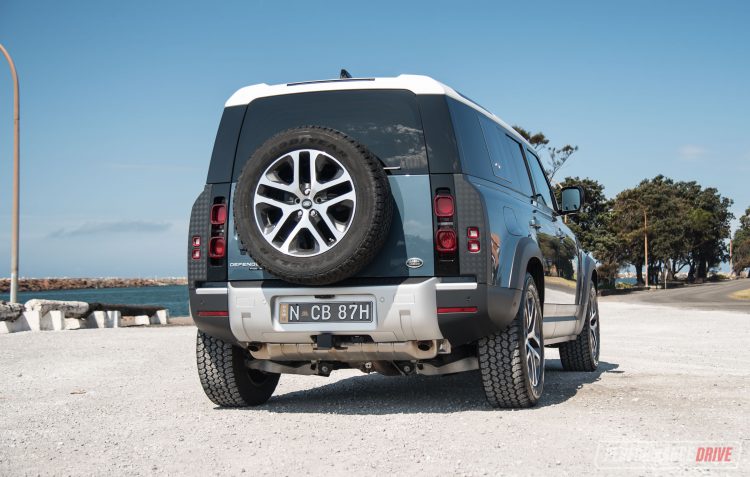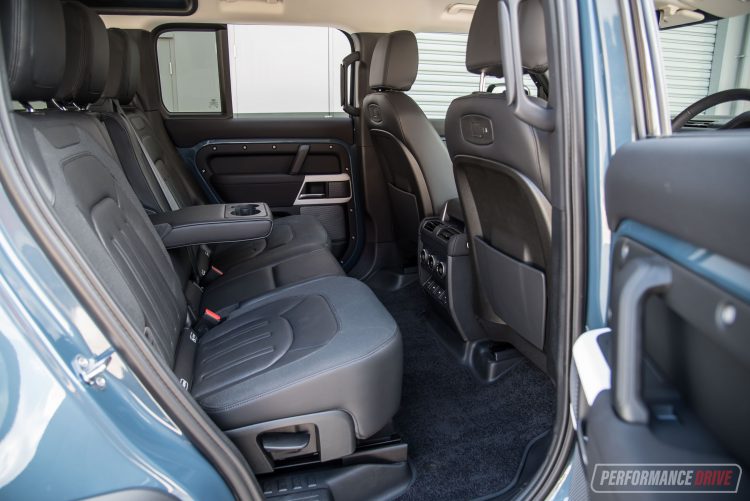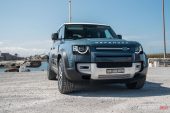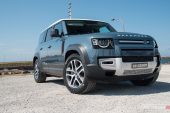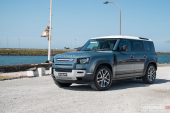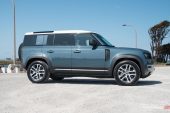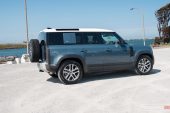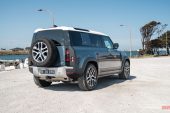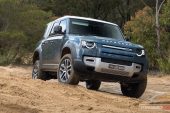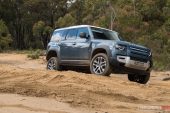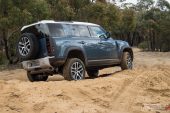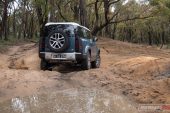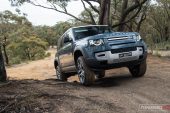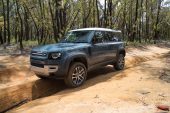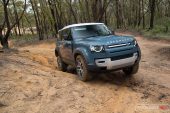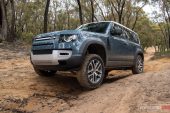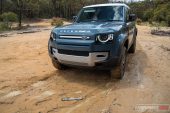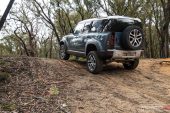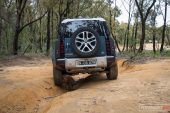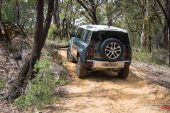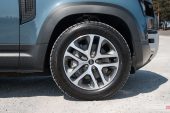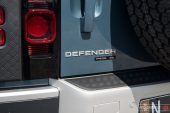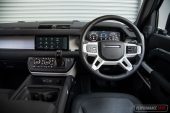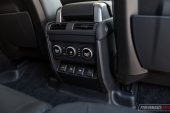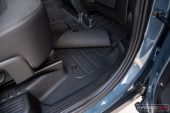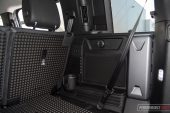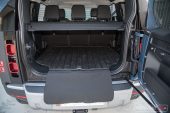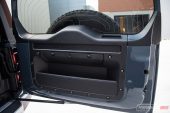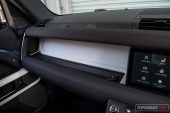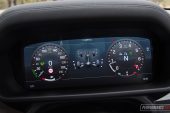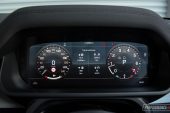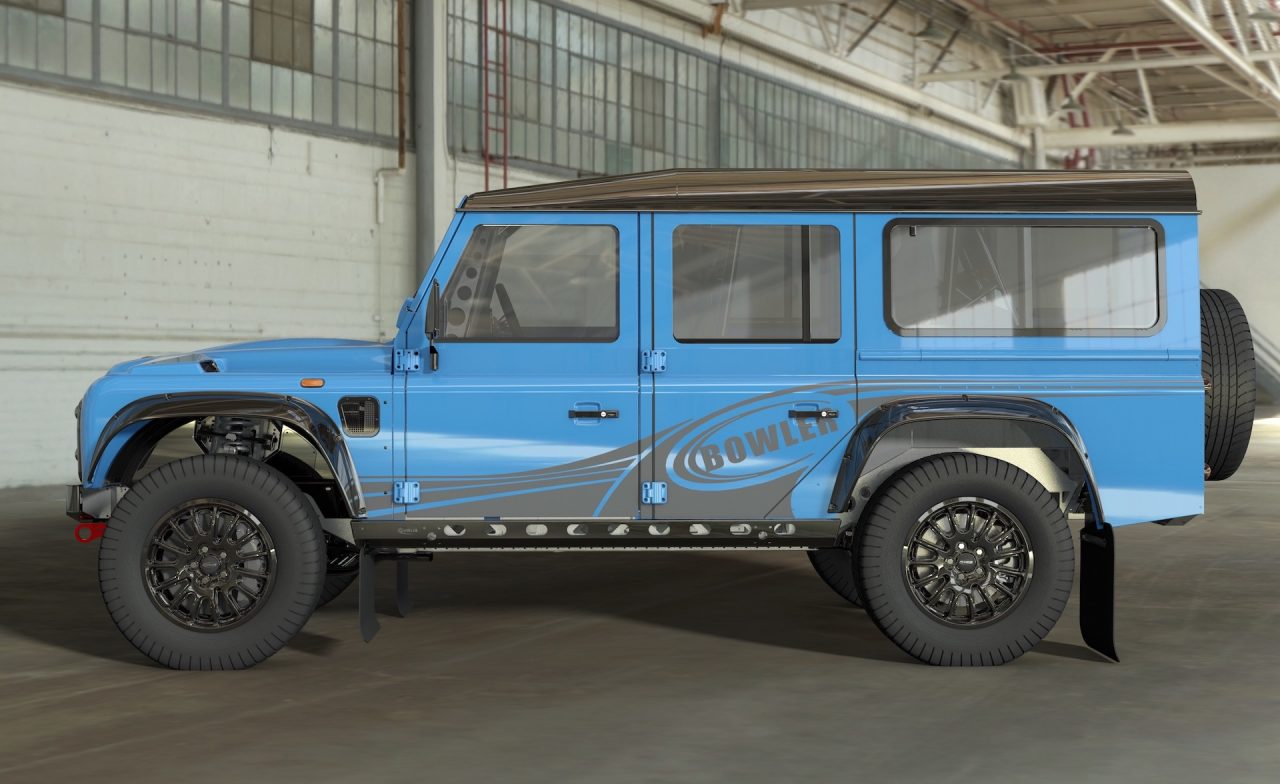It must have been a daunting yet very exciting time for the designers and engineers first tasked with replacing the iconic Land Rover Defender. This has big shoes to fill, and the nameplate, no doubt, has millions of fans ready to scrutinise every new detail.
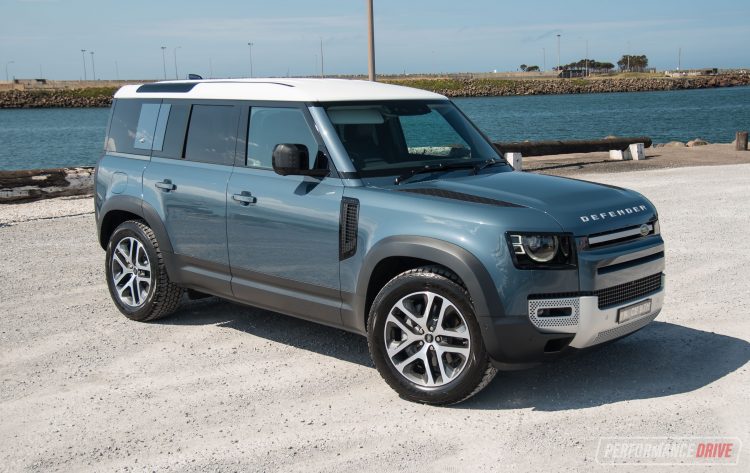
There’s been a few modern remakes in the last couple of years, including the new Toyota Supra, Suzuki Jimny, and BMW 8 Series. And now the Defender. Being a modern remake means it has to be modern and appeal to a new generation of buyers, while the remake aspect means it also has to live up to the legend.
Land Rover Australia is first launching the standard wheelbase 2020 Defender, called the 110, and will introduce the short wheelbase 90 a bit later on. Here we’re testing the flagship P400 engine option, consisting of a 3.0-litre turbo-petrol inline-six, and in mid-spec SE trim level. Buyers can step down to the S or up to the HSE. There’s also a special P400 X variant at the very, very top.
Prices for this variant start from $102,736 (excluding on-roads). This test vehicle, with options, is priced from an eye-watering $124,167. That’s a lot. Obviously. Even the bare-bones 110 D200 starts from $69,626, complete with steel wheels (actually pretty cool). We can already hear the traditionalists out there yelling at the screen, complaining that that’s just too much money.
We agree, to some extent. However, we have a sneaking suspicion Land Rover is trying to swipe some sales from Mercedes-Benz G-Class buyers. In that, this is surprisingly luxurious, yet also very capable. Let’s have a closer look.
2020 Land Rover Defender 110 P400 SE – THE SPECS
[column width=”47%” padding=”6%”]Engine: 3.0-litre turbo inline-six
Output: 294kW@6500rpm / 550Nm@2000-5000rpm
Transmission: Eight-speed auto
Drive type: Four-wheel drive, locking centre & rear diff
Wheels: F & R: 20×8.5, 255/60
ANCAP: Not tested
Tare weight: 2238kg
Power-to-weight: 7.61:1 (kg:kW)
Official fuel economy: 9.9L/100km
Economy during test: 13L/100km[/column] [column width=”47%” padding=”0″]Fuel capacity/Type: 90L/95 RON
Power efficiency: 29.69kW:L/100km
0-60km/h: 3.46 seconds*
0-100km/h: 6.90 seconds*
60-110km/h: 4.49 seconds*
1/4 mile: 14.96 seconds at 156.7km/h*
Max acceleration: 0.711g
100-0km/h braking: 3.36 seconds at 43.73 metres*
Max deceleration: -1.092g
Decibel at idle: 48*
Peak decibel at 60-100km/h: 83*
Priced from: $102,736[/column][end_columns]
* Figures as tested by PerformanceDrive on the day. Factory claims may be different
2020 Land Rover Defender 110 P400 SE – THE PACKAGE
Let’s start by saying the exterior design is bloody brilliant. A rounder and ‘softer’ theme likely helps the new model meet the latest regulations in safety and to help with aero efficiency. But we love how the designers have worked in plenty of traditional elements. You have the ‘alpine light’ roof windows, for example, the high-rise flat bonnet, and the completely vertical rear end.
This test vehicle also showcases the Tasman Blue paint option with the white contrast roof ($1950), which is inspired by the blue and white theme from classic models. There’s also chequer-plate-style trims for the side mirrors and bonnet, similar to the classics, and the spare wheel is mounted on the side-hinged tailgate for easier access.
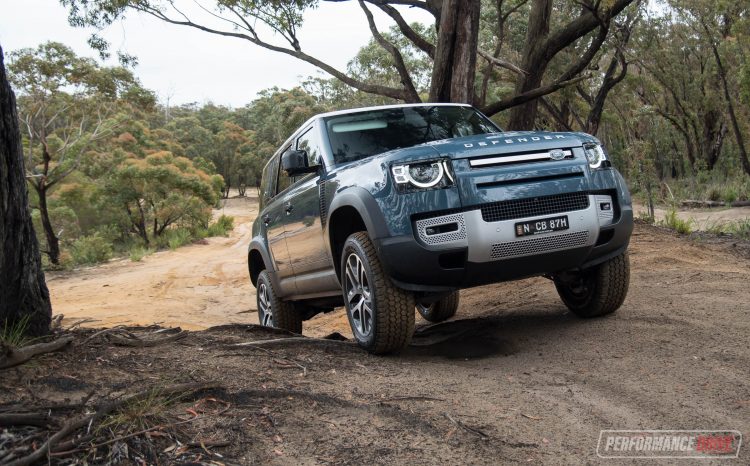
Overall, we think it looks awesome. It looks like a concept car that will never see the light of day. Yet here it is. There are some serious off-road credentials with this design, too. It’s not just about looking stylish and fresh. You might have noticed the extremely short front and rear overhangs, for example.
These provide incredible approach and departure angles, with 37.5 and 40 degrees, respectively, when the standard air suspension is raised to its highest setting. There’s also a whopping 291mm of ground clearance, in the highest setting. We can’t think of any mainstream four-door vehicle that tops these figures – even the Wrangler Rubicon offers only 252mm of clearance.
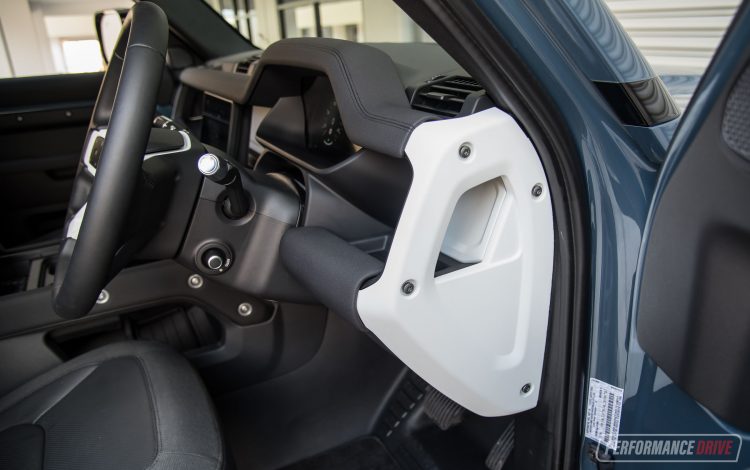
As impressive as the exterior might be, we think the interior is even better. Land Rover has worked in so many interesting, innovative, practical, and genuinely utilitarian aspects in here. The floor, for example, is completely plastic so it’s easy to clean. And check out the dash with its full-width shelf that features a grippy rubber lining all the way along. At each end is an integrated grab-handle.
And then there’s the centre console, with its dual-level shelving complete with USB and USB-C and 12V sockets. Two cup holders are presented up the top, and there’s a sizeable centre storage box. You won’t be wanting for more storage space, that’s for sure. You can even hide your phone or sensitive items behind the floating touch-screen.
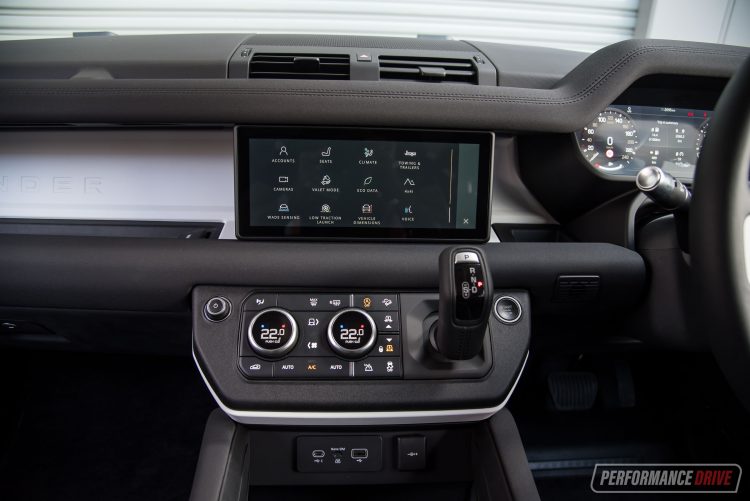
Land Rover touch-screens in recent times haven’t been regarded as the epitome of their segment. We haven’t minded them, but there’s often been superior systems out there. Now, the company is introducing its next-gen system called Pivi Pro. It is a huge improvement over the predecessor. We really like the graphics and colour palette, and the functionality is also drastically improved. It’s significantly quicker to load than previous JLR systems, and it supports Android Auto and Apple CarPlay as standard.
In terms of a successor to the classic Defender, this is obviously in a different world in terms of on-board entertainment and connectivity. However, in that regard, the Defender has become more complex. A little too complex, perhaps? During our test we jumped in this example one morning and the screens just wouldn’t turn on. We had to run a complete cycle through and reset, locking/unlocking and so on, three times before the screens started up. Oddly, it was only this one occasion out of a seven-day test.

Pairing beautifully with the infotainment system is a nice new digital instrument cluster. This presents one of the best graphics displays we’ve seen in a long while. The digital gauges have been designed to look like they are machined from steel, and there’s subtle dark greys, blues and greens that seem to present perfectly with this style of vehicle.
There are options to configure different layouts, including having the sat-nav map in the middle or having a ‘reduced’ theme or trip info and so on. Land Rover is persisting with its compass-style button control toggle on the steering wheel for the cluster. We think it can be a bit fiddly to use when driving. The buttons feel really sturdy and well-made, though.
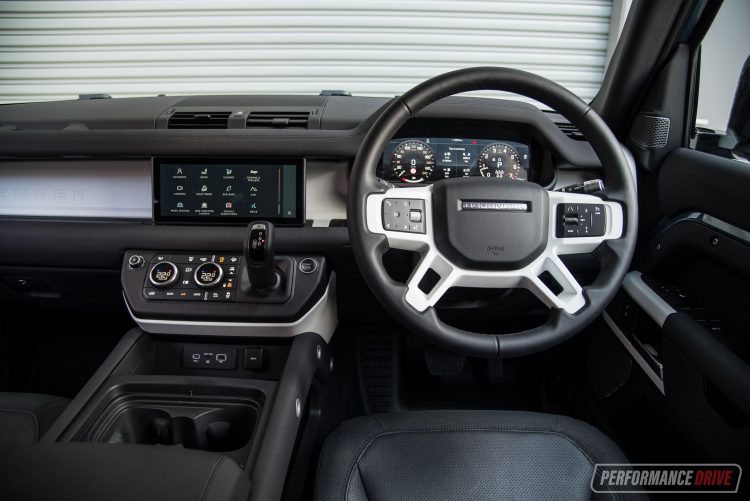
As for the passenger space, you won’t be needing any more headroom, that’s for sure. The seats are mounted high and feature a thick frame, which means you do need to jump up to get in when the suspension is raised. There is a “comfort access” mode to help with this. The cabin orientation is definitely narrow and tall as opposed to wide and low, too. There’s plenty of passenger space width-wise, we just mean the ratio of width:height seems more skewed upwards. Like the classics.
Rear passengers can be treated to yet more charging ports, and this test vehicle shows off the full climate control option with separate temperature and fan speed controls. Legroom is boundless, and the plastic floor carries through, albeit with premium mats over the top which likely help with cabin acoustics. This example also has the optional third-row seats ($3393, with heating), which fold down completely flat and out of sight.
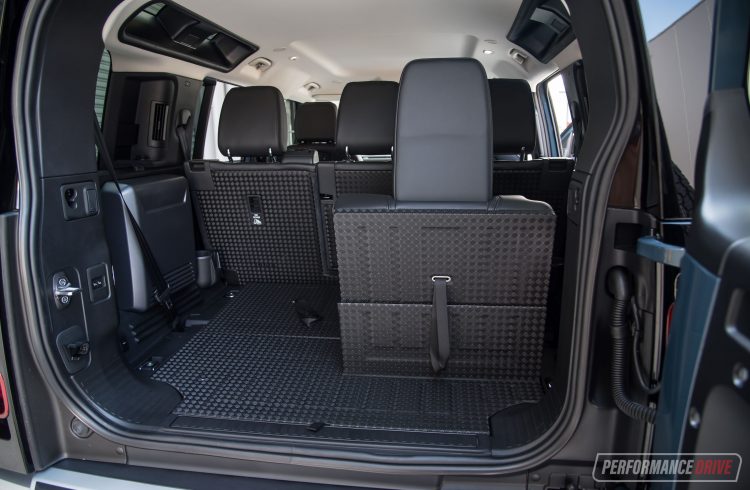
The second row is slide-adjustable so you can prioritise legroom in either direction. Legroom in the third row is restricted in any case, with foot room in particular really impacting the overall comfort. However, kids will be happy, especially with their own cup holders conveniently worked into the rear compartment. This vehicle also has charging ports for the third row, and separate climate control with rearward-facing vents within the C-pillar.
Hardened plastic is used to line the backs of the seats, so, when they’re folded down you basically have a flat and durable working space. With both rear rows down you also have a huge 2380L of volume to utilise. Rearward visibility for the driver is restricted with all three seat rows up as the headrests poke right up high. Fortunately, the SE comes with a full surround-view camera system as standard.
2020 Land Rover Defender 110 P400 SE – THE DRIVE
On the road the new Defender does feel similar to the latest Discovery. It’s based on the same aluminium-intensive D7 platform, although it adopts the D7x codename here. The air suspension means the ride is absolutely sublime, and there’s ample wheel travel so no speed bump is ever going to cause a bottom-out or any unexpected shunts in the cabin.
This translates to a comfortable and relaxing cruise on the highway. There is a tiny bit of road roar on some tarmac surfaces with these 255/60 all-terrain tyres, but wind noise is surprisingly low for such a big and bulky vehicle. It is a very touchy area for the Defender; on one hand, the classic models were quite crude during highway conditions, whereas with this new model, it will reach a wider target market thanks to its ability to behave and drive, essentially, as a luxury SUV in these circumstances.
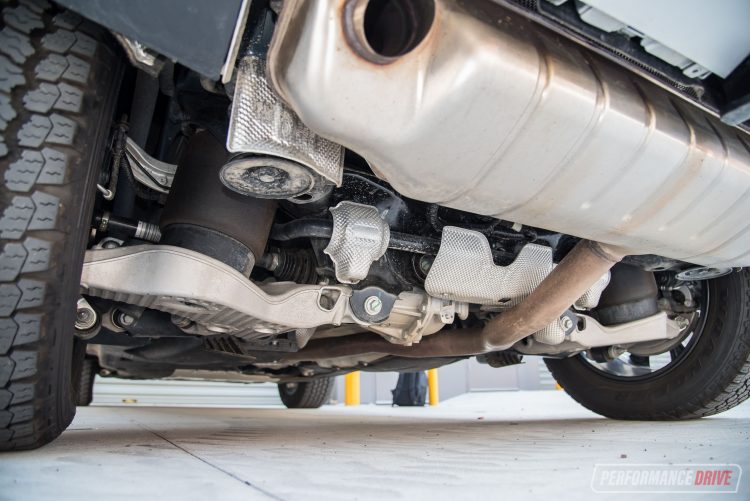
Once you start tipping into corners you quickly realise this is an off-road vehicle at its core. There is some body roll and lean, but it holds steadily when it reaches its braced position. Mid-corner bumps do cause some bounce and wallowing to occur, albeit without impacting directional stability. In other words, it can feel uneasy when pushed but the underlying foundations can manage it. We think the Discovery handles the twisty stuff more competently, but that’s exactly how it should be.
Now, it’s one thing to imagine the design of a new Defender, and then another to come up with a practical yet contemporary in-car environment. But what sort of engine should it have? Land Rover has worked its magic with this one. The P400 consists of a 3.0-litre turbo-petrol inline-six that also features an additional electric compressor. All up, it develops 294kW and 550Nm. How cool is that?
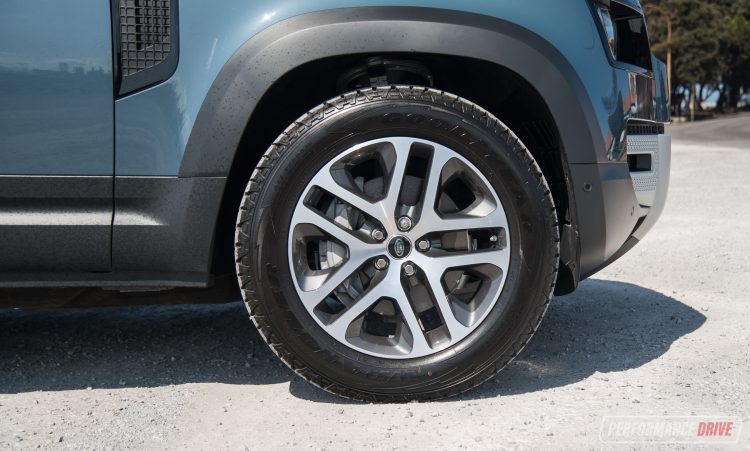
Again, this seems like a pipe dream. We know the old Defender was available with a small V8 in some markets, but this is on a completely different level. Land Rover claims 0-100km/h takes just 6.1 seconds, which is properly quick, even surpassing some of the hottest of hot hatches. During our testing the best we could manage on a private road was 6.90 seconds. However, our tests were conducted in fairly warm conditions.
With strong mid-range pull, generating peak torque between 2000-5000rpm, this engine doesn’t need to be revved hard to surge through traffic. Aside from a mild delay during very slow speeds, the eight-speed transmission is responsive and intuitive, making the most of the engine’s broad delivery. The engine is very smooth as well, and produces a subtle inline-six roar from inside the cabin.
There are a handful of driving models to choose from, but no dynamic mode in this JLR model, understandably. In saying that, we think it could be beneficial to have a ‘touring’ mode available. This could lower the suspension down and firm up the dampers a touch, purely for those long, windy open roads. After all, the hardware is already there.
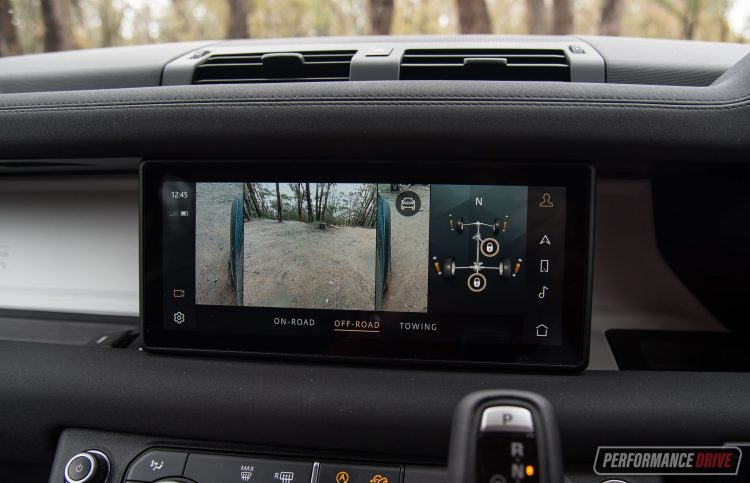
This vehicle features the optional electronic active differential with brake-type torque vectoring. We suspect this is what could be causing the minor yet noticeable delay when applying any level of power during very low speeds. It also features the Towing Pack ($3702), which bundles the Terrain Response 2 and All Terrain Progress Control systems. It includes a tow hitch receiver and Advanced Tow Assist. Low range and locking centre and rear differentials further assist with progression in sticky conditions.
Okay, so what about the off-road performance? In short, nothing we threw at this test vehicle scratched the surface. Admittedly, our testing conditions weren’t all that challenging for a proper off-road vehicle like this, but even still the Defender just goes anywhere you point it. In fact, the only trouble we had was with the front number plate; it fell off during a mud splash. Hardly a concern regarding its performance.
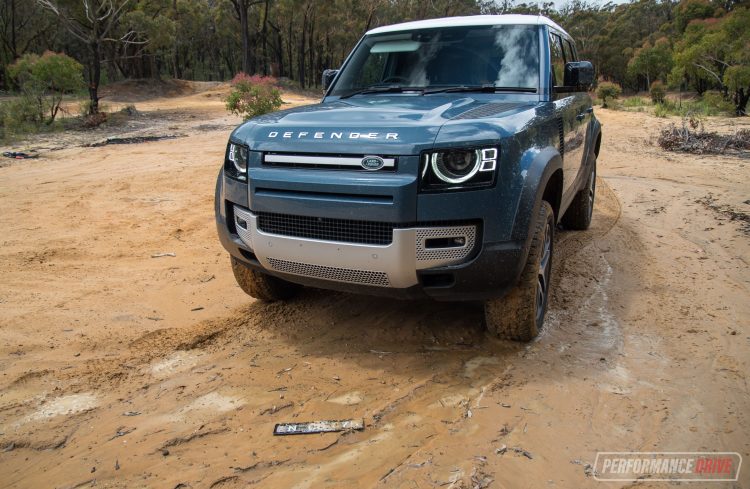
Wheel articulation is impressive in terms of the ability for the wheels to extend. However, it doesn’t seem like there is much compression range on the other end. As in, the wheels don’t seem to push right up into the arches. They obviously don’t need to as it pulls through anyway. Over a deeply-rutted section the front wheel popped into the air, only slightly. In this case we engaged low range and activated the centre and rear differential locks and it pulled straight through.
In more common dirt road conditions the Defender is really comfortable, and it actually seems more at home here than on the highway. Corrugations and potholes are absorbed wonderfully, and the wheels always feel firmly planted on the ground. Not only does it feel confident, the grip and overall safety in these conditions makes it a very attractive package. If you constantly travel on dirt roads and you’re looking to buy a new SUV, we recommend you check out the Defender very closely. This is its natural habitat.
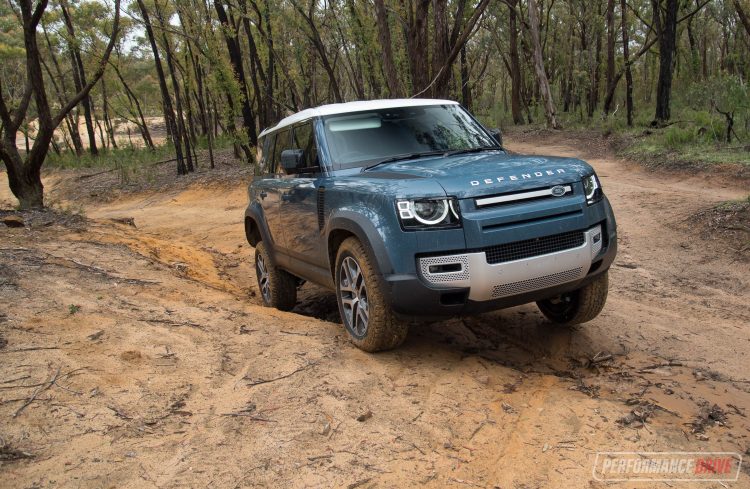
In terms of economy, we managed around 13L/100km, against the official average of 9.9L/100km. Our average is quite a bit higher than what we managed in the Range Rover Vogue P400 recently, with the same engine. In that we scored 10.1L/100km. However, that included a trip to Canberra and back, from Sydney. But it could give you some idea of the potential of this powertrain in the Defender. The Defender’s chunky tyres and boxier shape no doubt contribute to a higher official average than the Vogue’s 9.4L/100km rating.
2020 Land Rover Defender 110 P400 SE – THE VIDEO
2020 Land Rover Defender 110 P400 SE – THE VERDICT
The new Defender is a very smart evolution on what was a classic yet unsafe (by today’s standards), unrefined, and very basic albeit very likeable off-road vehicle. For those out there complaining that the new model is too soft and more of a Discovery, you might be better off buying a ute or a 70 Series LandCruiser this time around. This is an all-new model, so now it is safe, and kinder to the environment, and presents a more sophisticated and up-market design that will draw in a wider range of buyers.
We can understand why Land Rover has taken this path. But even taking all of that into account, we think the new model maintains extreme off-road capability. And in exchange for ruggedness and simplicity, you get something that’s in another dimension altogether in terms of refinement, on-road dynamics, and performance.
Personally, this is one of the coolest vehicles I’ve driven so far this year. I love the design, the innovative yet suave yet practical interior, and the P400 engine. My only problem with it is the price. It’s essentially the same as the Discovery, and even close to some Range Rover Sport models.
[column width=”47%” padding=”6%”]PROS:
– Such a cool design
– P400 inline-six; very smooth and powerful
– Seriously capable off road
– New Pivi Pro touch-screen and sharp digital cluster
– Interior convenience, practicality, and versatility
[/column] [column width=”47%” padding=”0″]CONS:
– Lots of electronics; test car had minor glitches
– Not as simple and rugged as it used to be (probably only matters to old-school fans)
– Very expensive[/column][end_columns]
As always, if you’re thinking about buying a new car don’t forget to click here to speak with our car buying specialists.
